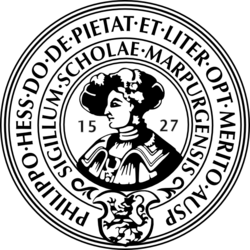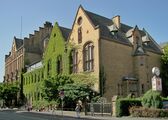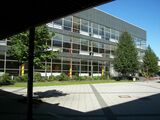Organization:University of Marburg
Philipps-Universität Marburg | |
 | |
| Latin: Schola Marpurgensis | |
| Type | Public |
|---|---|
| Established | July 1, 1527 |
| Budget | € 335.6 million[1] |
| Chancellor | Friedhelm Nonne |
| President | Katharina Krause [de] |
Academic staff | 2,657[2] |
Administrative staff | 1,794[2] |
| Students | 26,726[3] |
| Location | Marburg , Hesse , |
| Campus | University town |
| Affiliations | Compostela Group of Universities |
| Website | www.uni-marburg.de |
 | |
The Philipps University of Marburg (German: Philipps-Universität Marburg) was founded in 1527 by Philip I, Landgrave of Hesse, which makes it one of Germany's oldest universities and the oldest Protestant university in the world. It is now a public university of the state of Hesse, without religious affiliation. The University of Marburg has about 25,000 students and 7,500 employees and is located in Marburg, a town of 72,000 inhabitants, with university buildings dotted in or around the town centre. About 12% of the students are international, the highest percentage in Hesse.[4] It offers an International summer university programme and offers student exchanges through the Erasmus programme.
Marburg is home to one of Germany's most traditional medical faculties. The German physicians' union is called Marburger Bund.
History
In 1609, the University of Marburg established the world's first professorship in chemistry. In 2012 it opened the first German interactive chemistry museum, called Chemicum. Its experimental course programme is aimed at encouraging young people to pursue careers in science.[5]
Nazi period
20 professors were expelled in 1933, among them Wilhelm Röpke who emigrated and Hermann Jacobsohn who committed suicide.
Academics
Research
The university is most famous for its life sciences research, but is also home to one of the few centers that conduct research on the middle east, the CNMS (center for near and middle eastern studies). The departments of psychology and geography enjoy an outstanding reputation and reached Excellence Group status in the Europe-wide CHE Excellence Ranking 2009.
The strong research is also illustrated by its participation in several SFBs (Sonderforschungsbereiche). These collaborative research centres are financed by the German Science Foundation DFG. They encourage researchers to cross the boundaries of disciplines, institutes, departments and faculties within the participating university. The current SFB at Philipps-University Marburg are:[6]
- SFB/TR17 – Ras-dependent Pathways in Human Cancer (started 2004; with Julius-Maximilians-Universität Würzburg)
- SFB/TR22 – Allergic response of the lung (started 2005, with Research Center Borstel and LMU Munich)
- SFB/TR81 - Chromatin Changes in Differentiation and Malignancies (started 2010, with Justus-Liebig Universität Gießen)
- SFB-TRR 84 - Innate Immunity of the Lung (started 2010, with Charité Universitätsmedizin Berlin, FU Berlin, Robert-Koch-Institut, Max-Planck-Institut für molekulare Genetik, Max-Planck-Institut für Kolloid- und Grenzflächenforschung, Justus-Liebig-University Gießen)
- SFB 593 – Mechanisms of cellular compartmentalisation and the relevance for disease (started 2003)
- SFB 987 - Microbial Diversity in Environmental Signal Response (started 2012, with Max Planck Institute for Terrestrial Microbiology, Marburg)
- SFB 1083 - Structure and Dynamics of Internal Interfaces (started 2013, with Donostia International Physics Center San Sebastián, Spain)
- SFB 1021 - RNA viruses: RNA metabolism, host response and pathogenesis (started 2013, with Justus-Liebig Universität Gießen)
Collections of the university
- Alter Botanischer Garten Marburg, the university's old botanical garden
- Botanischer Garten Marburg, the university's current botanical garden
- Forschungsinstitut Lichtbildarchiv älterer Originalurkunden bis 1250 (Collection of photographs taken from medieval charters)
- Bildarchiv Foto Marburg (German national picture archive of arts)
- Religionskundliche Sammlung (Collection of religious objects)
- Deutscher Sprachatlas (Linguistic Atlas of Germany)
- Mineralogisches Museum (Museum of Mineralogy)
- Museum für Kunst und Kulturgeschichte (Museum of Arts)
Rankings
Template:Infobox world university ranking
Gallery
Notable alumni and faculty
Natural scientists who studied or taught at the University of Marburg:
- Ludwig Aschoff
- Emil von Behring
- Karl Ferdinand Braun
- Klaus Bringmann
- Robert Bunsen
- Adolf Butenandt
- Georg Ludwig Carius
- Franz Ludwig Fick
- Hans Fischer
- Edward Frankland
- Frederick Augustus Genth
- Johann Peter Griess
- Karl Eugen Guthe
- Otto Hahn
- Johannes Hartmann
- Thomas Archer Hirst
- Erich Hückel
- Hermann Knoblauch
- Hermann Kolbe
- Albrecht Kossel
- Otto Loewi
- Carl Ludwig
- Hans Meerwein
- Ludwig Mond
- Denis Papin
- Heinrich Petraeus (1589–1620)
- Otto Schindewolf
- Sunao Tawara
- John Tyndall
- Wilhelm Walcher
- Alfred Wegener
- Georg Wittig
- Alexandre Yersin
- Karl Ziegler
- Theodor Zincke
- Gerhard Wilhelm Goetze
Marburg was always known as a humanities-focused university. It retained that strength, especially in Philosophy and Theology for a long time after World War II. Theologians include:
- Rudolf Bultmann
- Friedrich Heiler
- Wilhelm Herrmann
- Aegidius Hunnius
- Andreas Hyperius
- Otto Kaiser
- Jacob Lorhard
- Rudolf Otto
- Kurt Rudolph
- Paul Tillich
- August Friedrich Christian Vilmar
Philosophers include:
- Wolfgang Abendroth
- Ernst Cassirer
- Hermann Cohen
- Hans-Georg Gadamer
- Nicolai Hartmann
- Martin Heidegger
- Hans Jonas
- Friedrich Albert Lange
- Karl Löwith
- Paul Natorp
- Christian Wolff
- Eduard Zeller
- Karl Theodor Bayrhoffer
- Hans Heinz Holz
Other notable students and faculty include:
- Hannah Arendt
- Karl Barth
- Hermann Behrends (1907–1948), German Nazi SS officer executed for war crimes
- Gottfried Benn
- Gerold Bepler
- Georg Friedrich Creuzer
- T. S. Eliot (who had to quit a summer school in August 1914, at the start of World War I)
- José Ortega y Gasset
- Jacob Grimm
- Wilhelm Grimm
- Caspar Friedrich Hachenberg
- Gustav Heinemann
- Beatrice Heuser
- Kim Hwang-sik
- Helmut Koester
- Wilhelm Liebknecht
- Mikhail Lomonosov
- Carlyle Ferren MacIntyre
- Ulrike Meinhof
- Friedrich Paulus
- Boris Pasternak
- Ernst Reuter
- Isaac Rülf
- Ferdinand Sauerbruch
- Friedrich Carl von Savigny
- Annemarie Schimmel
- Heinrich Schütz
- Manfred Siebald
- Leo Strauss
- Wilhelm Röpke
- Costas Simitis
Dmitry Ivanovich Vinogradov * Ingeborg Weber-Kellermann
See also
- List of early modern universities in Europe
- List of universities in Germany
- University hospital Giessen und Marburg
Notes
- ↑ "Aktuelle Zahlen auf einen Blick" (in de). https://www.uni-marburg.de/profil/statistik/zahlen. Retrieved 2017-06-21.
- ↑ 2.0 2.1 "Employees". https://www.uni-marburg.de/profile-en/statistik-en/employees. Retrieved 2017-04-20.
- ↑ "Anzahl der Studierenden ab 1986 jeweils im Wintersemester" (in de). https://www.uni-marburg.de/profil/statistik/studizahlen/anzahlstudies.pdf. Retrieved 2017-04-20.
- ↑ "Uni International - Philipps-Universität Marburg". https://www.uni-marburg.de/international-en-old. Retrieved 21 July 2015.
- ↑ ""Chemikum Marburg" hat ein dauerhaftes Domizil". Informationsdienst Wissenschaft e.V. online. 12 February 2011. https://idw-online.de/pages/en/news454460. Retrieved January 23, 2012.
- ↑ "Sonderforungsbereiche - Philipps-Universität Marburg - Referat für Forschung und Transfer - Sandra Basenau". https://www.uni-marburg.de/forschung/forschungsprofil/kopdfg/sfbs. Retrieved 21 July 2015.
External links
[ ⚑ ] 50°48′39″N 8°46′25″E / 50.81083°N 8.77361°E











